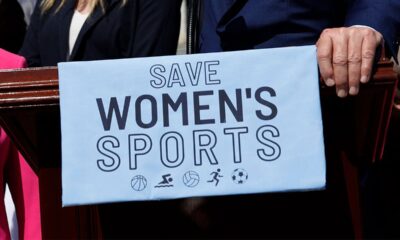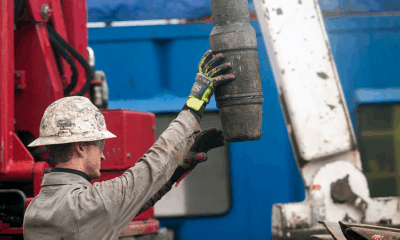Business
Is this the solution to California's soaring insurance prices due to wildfire risk?
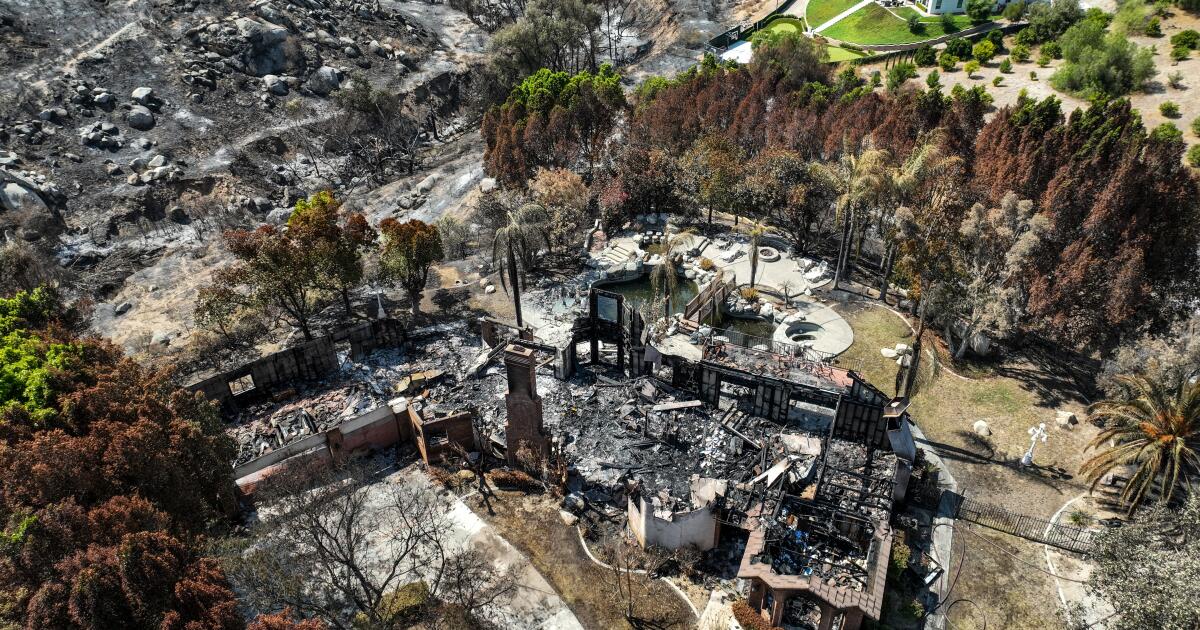
In the past several years, homeowners across the state have been either burdened with extremely high insurance premiums or have struggled to find coverage at all. Wildfires have sent California’s homeowners insurance market into crisis and the situation is only getting worse. So far, 2024 has seen 219,247 acres burned, more than 20 times the amount this time last year. As wildfires become more frequent and destructive, insurers have worked to lower their risk exposure through rate hikes, nonrenewals, and even halting new policies in the state entirely.
New buyers and those whose policies have not been renewed have limited options since the biggest companies, State Farm, Farmers, Allstate, USAA, Travelers, Nationwide and Chubb, have limited or paused new policies in the last few years. Earlier this month State Farm’s cancellations of 30,000 homeowner policies mostly in high wildfire risk areas, took effect. In late June, State Farm requested a 31% rate increase, its largest increase in recent history, on the heels of a 22% increase earlier this year. Allstate also recently filed a request for a significant 34% rate increase.
Homeowners are finding the expense and lack of options unsustainable. Sharon Goldman, longtime resident of the Pacific Palisades, has not had her policy canceled yet, but she has seen increases to her premium and worries she could be next. In her ZIP Code the wildfire risk is high, and State Farm decided to not renew 70% of their policies. Starting in 2019, rates of nonrenewals in high- and very high-risk areas grew to 14% compared with 3% and 2% for moderate- and low-risk areas.
Goldman, using her maiden name out of concern for retribution from State Farm, has paid her premiums each year since she bought her home 50 years ago. She has never filed a claim. But she has seen her rate increase 78% in the past two years. Her agent has told her that her fire coverage will be replaced with the state-run FAIR plan in 2025, an increasingly common insurer strategy that leaves homeowners paying more for less coverage.
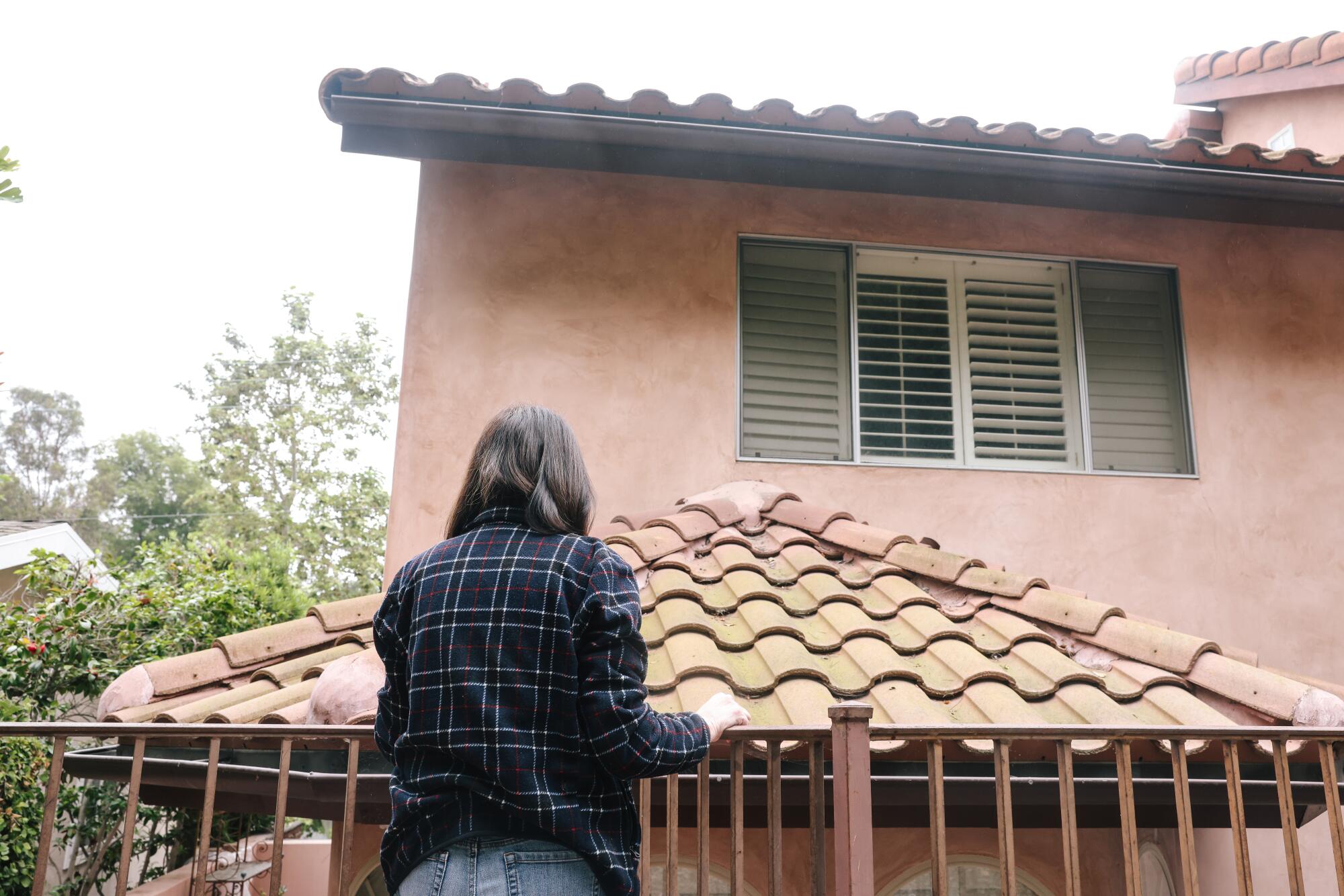
Sharon Goldman poses for a portrait in Pacific Palisades in June. She is one of the many California homeowners struggling to maintain home insurance as costs increase and policies are dropped due to wildfire risk.
(Dania Maxwell/Los Angeles Times)
Goldman and her neighbors are left wondering what options they have left. She hears stories of people paying tens of thousands a year, an impossible amount for her to cover on her retirement budget. She has started looking into moving out of state and out of the home where she raised her children.
While the state does not require insurance, mortgage lenders do. So, going without is not an option for many. Those whose mortgage is paid off, like Goldman, may not be comfortable leaving their home, typically their most expensive asset, uninsured. High rates and loss of fire coverage have pushed desperate homeowners to riskier nonadmitted carriers or to the state-run FAIR plan, meant to be the plan of last resort. But the California Department of Insurance worries that it is quickly becoming overburdened.
Over the past year, Insurance Commissioner Ricardo Lara has been rolling out his plan to increase policy writing in vulnerable areas and get people off of the FAIR plan. One big component of his strategy is allowing insurers to use wildfire catastrophe models to set overall rates. Insurers say the tool would help them more accurately predict the correct rate for the amount of risk.
As a trade-off, Lara says companies that use these models will be required to increase service in distressed areas with a high wildfire risk and a high concentration of FAIR plan policies.
In public workshops held by the Department of Insurance, consumer advocates raised concerns about a lack of transparency with “black box” models that may be used to justify unnecessary rate hikes. Industry advocates are concerned the plan will take too long to implement when they desperately need changes now.
How likely is it a house will be damaged in a wildfire?
There are many versions of catastrophe models. Each modeling company has their own proprietary analysis but they all generally use the same data inputs to answer the same question.

The Harwarden fire burned over 500 acres, destroying three large homes and damaging seven others.
(Jen Osborne / For the Times)
Each modeled event starts with an ignition, the probability that a fire will start at that location, spread, the probability that the fire will travel based on the land cover in the area, and property characteristics. Using those data, the model simulates a large number of possible outcomes for a given location, estimates the likelihood that a structure will burn from wildfire, and calculates the loss for any buildings there.
The USDA Forest Service developed a national analysis of wildfire risk that is similar to what models created for insurance companies would look like. Based on vegetation and fire-behavior fuel models, topographic data, historical weather patterns and long-term simulations of large wildfire behavior, their wildfire likelihood map shows the probability of a fire in any given year.
A critical part of predicting the potential spread of the fire is the available fuel. The Forest Service’s land cover classifications are used in many wildfire models. They specify 40 different fuel types such as grass, shrub, timber, and nonburnable types. Each category is further subdivided based on depth of the cover and humidity or aridity of the climate.
For example, in an arid climate, coarse continuous grass at a depth of 3 feet would have a very high spread rate. A combination of low grass or shrubs and dead leaves or needles in the forest would have a low spread rate.
Property characteristics such as the type of roof or whether the siding is fire-resistive make a significant difference in whether a structure will ignite from wildfire embers. The Center for Insurance Policy and Research found that structural modifications can reduce wildfire risk up to 40%, and structural and vegetation modifications combined can reduce wildfire risk up to 75%.
All of these factors are combined in the model with information about the rebuilding cost and level of coverage to generate an amount of risk unique to the individual property.
Could these models turn the industry around?
Currently, companies are required to calculate their projected losses, on which their overall rates are based, using a historical view of wildfire loss over the previous 20 years. As wildfires increase, however, this means that the average loss trails behind the current state of wildfire risk.
Nancy Watkins, an actuary and principal at the insurance consulting firm Milliman, said that she believes the inclusion of catastrophe models could save the industry. She analyzed the effect of a model on rates compared with using just historical experience. While the rates would generally be higher, the increases would be more even.
In April during a public meeting, Allstate said that if wildfire catastrophe models were allowed, they would once again start writing new policies in the state.
But wildfire catastrophe models are already used by insurance companies in California for some business decisions and have been for some time. They use models to determine where to write or renew policies, which is one of the reasons nonrenewals have disproportionately happened in high-risk areas.
In recent rate filings, Allstate, Farmers and State Farm cited a modeled wildfire risk score as the basis for not renewing policies. Allstate used CoreLogic’s Risk Meter score in 2019 to classify all policies that fell above certain risk thresholds as ineligible for renewal. A 2023 filing from Farmers documents eligibility guidelines for new and renewing policies that sets a risk level using Verisk’s FireLine and Zesty.ai’s Z-FIRE scores. State Farm’s recent 30,000 nonrenewals are based on CoreLogic’s Brushfire Risk Layer.
Amy Bach, executive director of United Policyholders, says that wildfire models worked their way into rates without enough state oversight. “We didn’t regulate the use of risk scores and now [they] are having a dramatic impact on the market and the genie is out of the bottle.”
Some companies use models to assess relative risk between properties and adjust individual rates accordingly. State Farm multiplies its base rate by a location rating factor, calculated using catastrophe models produced by CoreLogic and Verisk. Areas with high wildfire risk have seen dramatic increases in the location rating factor in the past few years.
This process is called segmentation and the Department of Insurance is aware that it is opaque. Department spokesperson Michael Soller says, “People do not know what their risk score is. They don’t know what goes into the risk score. It’s a black box. Yet, the risk score can be used to [charge you] double what somebody else pays.”
While these situations are significant for some, they generally only apply to select high-risk properties. The median effect of the location rating factor has remained fairly stable.
But under the commissioner’s new policy, model results could also be incorporated directly into the overall rate. Soller says that one important difference in this new regulation is that for a model to be valid, it will need to incorporate property and community level risk mitigation into rates, including state agency forest thinning and utility company efforts. As more investment goes into making communities safer, in theory the rates should decrease.
Only you can prevent forest fires?
Wildfire mitigation happens at the state and local level. Since 2020, in addition to baseline spending, California has allocated more than $2.6 billion towards its wildfire and forest resilience package. 872 communities in the state are registered participants in Firewise USA, a program administered by the National Fire Protection Association that sets standards for fire safety.
For an individual, retrofitting one’s home for wildfire resistance is not cheap. On average, homeowners spend $15,000 on a new roof.
As of October 2022, companies such as State Farm that use wildfire models in segmentation are already supposed to give mitigation discounts. A February filing from State Farm breaks down how their discounts would work in a low-, medium- and high-risk area.
For the low-risk group, the dollar amount saved may not be worth the investment in mitigation. For the high-risk group, the slightly lower percentage reductions would still result in more substantial dollar amounts saved.
According to the State Farm documents, these discounts are given at a set rate for all properties across the state. Granular catastrophe models take into account the impact of mitigation on the property level, nearby community mitigation and any recent wildfire history that might indicate a temporarily reduced risk.
However, a complaint raised several times during the regulation workshops was that when homeowners do spend money, often thousands, on lowering risk, they do not see any changes in their insurance premiums. Some say their policies were still dropped.
Goldman has already completed the property-level mitigation work. She has a class A Spanish tile roof. She does the brush clearance every year. This past year it cost about $1,200. She even has an outdoor sprinkler system. But she did not learn about mitigation from her insurance company. Instead, it was on one of Bach’s monthly educational community calls where she got the idea to install fire-resistant vents.
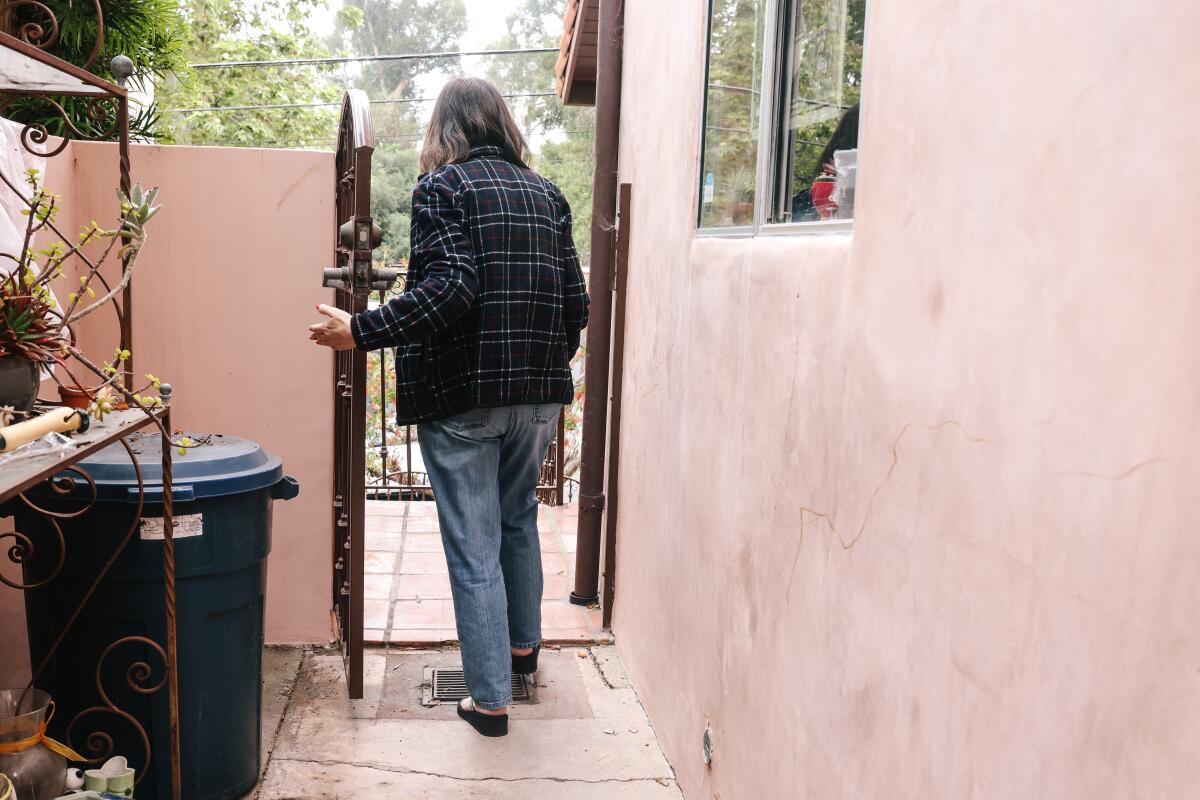
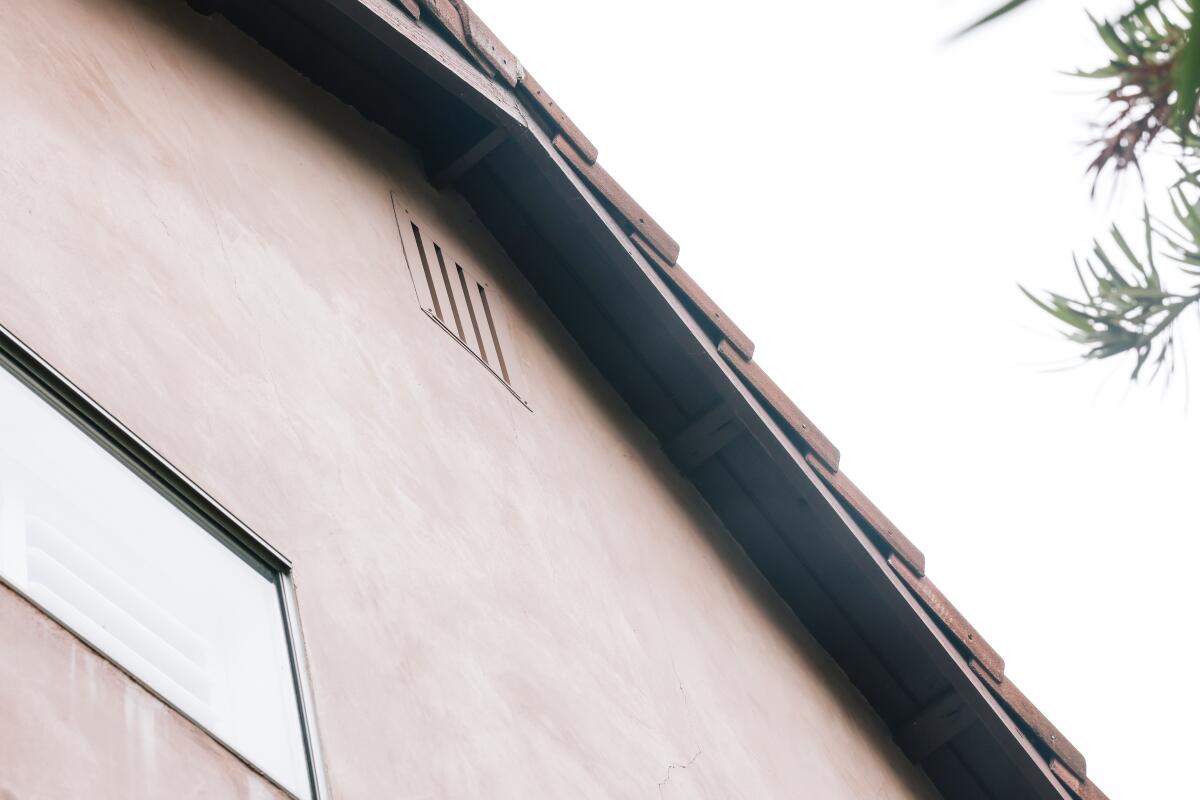

Sharon Goldman walks through the exterior of her home where she has lived for about 50 years and raised four kids in Pacific Palisades. (Dania Maxwell/Los Angeles Times)
And yet, she has not received a mitigation credit from State Farm and has not received any information about how to receive one. When she asked her agent whether the work she had done on her home qualified for a discount he said no. The Department of Insurance says that they review consumer complaints for rate accuracy and conduct regular examinations of insurance companies. They noted that concerned consumers should contact them to review their specific situation.
Making models a reality
The catastrophe modeling regulation requires insurers to submit their modeling information to the Department of Insurance for review by an internal model advisor and any necessary consultants. Some proprietary information is allowed to remain confidential but proponents of the plan say that the regulators will have all the information they need to assess the models even if the general public does not.

Firefighters work to douse a home on fire in Harwarden Hills, a high-end living community in Riverside.
(Jen Osborne / For The Times)
The department says it is still considering public input from the most recent workshop and has no further plans for additional workshops. Once the regulation is finalized there will be a public hearing. Commissioner Lara plans to have this regulation and the rest of the Sustainable Insurance Plan in place by the end of the year.
In addition to forward-looking catastrophe models, Lara’s plan will introduce the ability for insurance companies to include reinsurance costs in rates and to increase coverage in the FAIR plan. Details for both of those changes are expected to be released this month.

Business
Driverless disruption: Tech titans gird for robotaxi wars with new factory and territories
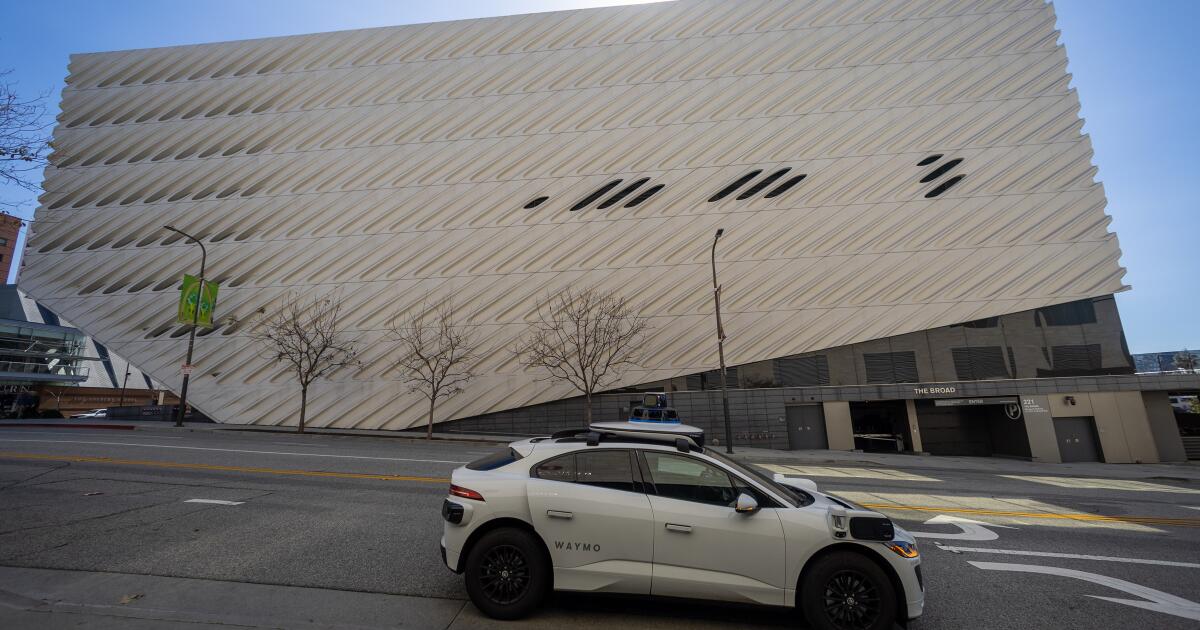
As three key players vie for dominance, the race to put driverless taxis on roads across the country is heating up.
Waymo, owned by Google’s parent company Alphabet, already offers paid autonomous rides in a handful of cities, including San Francisco and Los Angeles. Amazon’s robotaxi effort, known as Zoox, opened a new production facility in the Bay Area this week. The company has been testing its unique pill-shaped vehicles in California and Nevada since 2023.
Meanwhile, in Austin, Texas, Elon Musk just started testing driverless Teslas with the hopes of launching a commercial service soon. Musk unveiled a prototype for Tesla’s Cybercab late last year, touting his vision for an autonomous future and “an age of abundance.”
The arrival of self-driving tech could eventually affect society as much as the internet and smartphones did years ago, some experts predict. With Waymo leading the way and Tesla and Zoox trying to catch up quickly, a new status quo could be on the horizon, said Karl Brauer, an analyst with iSeeCars.com.
“Tesla has tried to catch up, and Zoox is a more recent competitor that’s hoping to be a serious player,” he said. “Waymo has been slow and steady and, as a result, is winning the race.”
According to some industry insiders, the U.S. is about 15 years from seeing widespread use of robotaxis, Brauer said. While Waymo taxis have become a common sight in the cities where they operate, weather conditions and charging infrastructure still limit their expansion.
On Wednesday, Waymo expanded its service area in Los Angeles County, where its vehicles now roam an area of more than 120 square miles. The company also increased its service area in San Francisco, expanding access to suburbs and Silicon Valley.
Days after Waymo’s announcement, Zoox opened a 220,000-square-foot facility in Hayward, Calif., that the company says will be able to produce 10,000 robotaxis per year. Zoox is preparing to launch its public ride-hailing service in Las Vegas and San Francisco this year.
Unlike Waymo vehicles, which are retrofitted Jaguars, Zoox is developing a purpose-built taxi with no steering wheel or gas pedals.
Zoox also has a manufacturing plant in Fremont, Calif., where the company develops its test fleets of retrofitted Toyota Highlanders. Tesla has a manufacturing facility in Fremont as well.
Musk has promised for years to deliver autonomous vehicles and a robust ride-hailing service. Lawmakers in Austin requested this week that he delay the rollout of his service in the city.
Tesla, Zoox and Waymo are the three remaining major U.S. companies in what was once a more crowded field, Brauer said. General Motors’ autonomous taxi company Cruise suspended operations in 2023 after one of its vehicles struck and dragged a pedestrian in San Francisco. Last year, Uber and Cruise announced a partnership that could put Cruise vehicles back on the road.
A company called Argo AI, backed by Ford and Volkswagen, was also developing driverless technology until it shut down in 2022.
The continued expansion of robotaxis depends on safe and successful testing, Brauer said. There have been several incidents related to Tesla’s Full Self-Drive mode, a technology currently available but still in development. Waymo has issued recalls of some of its vehicles on multiple occasions.
“If there’s a tragic result for any of these three companies during the testing and development process, it would likely slow down the entire industry,” Brauer said.
Business
Protesters are chasing federal agents out of L.A. County hotels: ‘A small victory’

At Pasadena’s AC Hotel earlier this month, dozens of protesters gathered in an effort to confront federal agents who had arrived in town amid demonstrations against the Trump administration’s mass deportation effort.
Pasadena Mayor Victor Gordo was among those present on June 7 as demonstrators holding signs with “ICE out of Pasadena” and other messages chased federal vehicles out of the luxury hotel’s parking garage, cheering and recording it all on their cellphones.
The mayor said the protest forced the agents to leave the place they were using for local accommodations during their L.A. operations, which involved protecting federal buildings downtown.
“Word got out that there were Homeland Security vehicles parked at the hotel,” Gordo told The Times. “People wanted to express their 1st Amendment rights and they did so in a lawful, nonviolent and respectful manner.”
After hours of noisy rallying, the hotel staff asked the feds to pack up their things and go, according to Gordo. By sunset, uniformed agents from the Federal Protective Service, part of the Department of Homeland Security, were seen walking out of the hotel with their bags stacked on a luggage cart in a video of the incident that went viral online. Their vehicles were escorted out of the garage by local police as protesters trailed behind.
Hotels have emerged as hot spots for confrontations between community members and immigration agents. Federal agencies, including U.S. Immigration and Customs Enforcement, sometimes rent blocks of rooms in places where agents are dispatched for major operations.
Hotels have emerged as hot spots for confrontations between community members and immigration agents.
(Jason Armond / Los Angeles Times)
The showdown in Pasadena was one of several recent instances of protesters coming together at hotels across the Los Angeles region to put pressure on their proprietors to offer no quarter to federal personnel during the Trump administration’s crackdown. The businesses, which rely on immigrant workers for cleaning and maintenance, have been cast into an awkward position — one that requires balancing politics with protecting their employees.
From Whittier to Hawaiian Gardens to Brea, concerned citizens have repeatedly taken to social media and whisper networks to share locations where they have spotted who they believe are federal agents. And people have followed up on such information by staging protests outside hotels in communities including Long Beach, Downey and Glendale.
Employees at the AC Hotel Pasadena referred inquiries to a spokeswoman, who did not immediately provide a comment. It was back to business as usual Tuesday afternoon at the Marriott property, which opened earlier this year. A man on a plush couch worked on his laptop, a woman sipped a beer at the bar and staff milled about.
Gordo said he had confirmed that there are no longer any Homeland Security agents staying at the property.
The Homeland Security press office did not immediately provide comment, and agencies under the department’s umbrella, including ICE and U.S. Customs and Border Protection, did not respond to inquires.
Protesters have been arrested this month for allegedly interfering with federal officers, and federal agencies have expressed concerns about the repercussions of people “doxxing” agents by sharing their locations and other personal information online.
“People are out there taking photos of the names, their faces and posting them online with death threats to their family and themselves,” Reuters reported acting ICE chief Todd Lyons said last week.

Pasadena police block the entrance to the Hotel Dena in Pasadena last week.
(Jason Armond / Los Angeles Times)
The crowd-sourced effort to spread information about where federal agents are holed up plays out mostly online.
In some instances, the unverified reports come from people who work at the hotels. Other times, hotel guests or area residents see suspected agents outside or in the lobby, or walk through parking lots in search of federal vehicles.
During the first days after the L.A. enforcement effort began, it was fairly easy to tell where agents were staying by looking for vehicles with agency logos. But it appears that they have caught on to the surveillance tactics of those who would like to see them go home.
On Monday, a Times reporter visited 13 hotels in three Southland counties — from Westchester to Garden Grove to Ontario — where federal immigration agents recently had been rumored to be staying, according to social media posts and alerts on apps and websites dedicated to tracking ICE activity. No vehicles in any of the hotels’ parking lots bore clear visual indications that they were federal agents’ cars, vans or trucks.
At five hotels, employees approached by The Times declined to comment. At three, employees agreed to speak but declined to give their names, citing corporate policies. Two of them said in brief interviews that they were not sure whether agents were staying on the premises. A third, who works at a chain hotel in Anaheim, said he had seen who he believed were ICE agents at the property last week, but they were no longer staying there.

Workers at the Hilton Pasadena show support for community members taking part in a June 12 protest.
(Jason Armond / Los Angeles Times)
“They didn’t bother anyone,” said the man, who declined to provide his name out of fear of reprisal from his employer or immigration authorities. “There were maybe, like, a dozen of them. It was a little concerning.”
Workers such as him have been subjected to political whiplash in recent days. Last week, President Trump wrote on Truth Social that “Our great Farmers and people in the Hotel and Leisure business have been stating that our very aggressive policy on immigration is taking very good, long time workers away from them.” That same day, a senior ICE official sent guidance to regional ICE officials directing them to avoid raiding farms, hotels and restaurants and instead emphasize other targets.
The development gave hotel employees hope that they were out of the crosshairs. But the Trump administration quickly reversed course, saying this week that there is now no reprieve for hotel workers and others who Trump had praised just days earlier.
Andrew Mark, a pastor at Pasadena Covenant Church, also addressed the crowd at the June 7 rally outside the AC Hotel. He said in an interview that he was impressed — but not surprised — that the community came together and forced change.
“There’s a deep pride in Pasadena. So I think that for agents to be staying in a hotel here, you feel … a sense that we don’t want this to be a place where they can stage and go out and target people,” he said. “The fact that they were based in a hotel in our community was unsettling.”
On Tuesday, Manuel Vicente sat behind his makeshift desk in a soundproof room at the Pasadena Community Job Center, which helps connect day laborers with employment opportunities. As director of Radio Jornalera, he creates audio and video content to help migrant workers, including content that informs them of the rights they have during encounters with immigration enforcement agents.
Vicente said he believes the successful protest at the AC Hotel Pasadena is an example of a saying he likes to quote, “Pueblo salva el pueblo,” or “Only the people save the people.”
“When they were kicked out of the hotel, everybody was excited,” he said. “It was a small victory, but our efforts made a difference. We need to be together to protect our community, to protect our workers.”
Business
Blumhouse acquires 50% stake in 'Saw' franchise

Horror production company Blumhouse has acquired a 50% stake in the long-running “Saw” franchise, buying the rights owned by producers Oren Koules and Mark Burg, the firm said Wednesday.
Santa Monica-based Lionsgate will continue to own 50% of the franchise, retain all domestic distribution rights for new feature films and still distribute worldwide for the library films. Los Angeles-based investment firm Content Partners has also acquired a stake in the library as part of the transaction, alongside Burg’s retained share, Blumhouse said.
Financial details were not disclosed.
Blumhouse will take the lead on international distribution for new feature films and will discuss global release strategies with Lionsgate on a film-by-film basis.
Blumhouse Chief Executive Jason Blum described the deal in a statement as “a strategic investment in one of the most recognizable and successful genre properties of the last two decades.” The 10-film franchise began in 2004 and has grossed more than a billion dollars in worldwide box office revenue.
“The Saw franchise has defined a generation of horror, and its cultural impact continues to grow,” he said.
With this deal, the franchise returns to filmmaker James Wan, who directed the first “Saw” film. Wan’s production company, Atomic Monster, merged with Blumhouse last year.
“Over the course of ten chilling and thrilling ‘Saw’ films, Oren and Mark have been outstanding partners, producers and stewards of this billion-dollar franchise,” Adam Fogelson, chair of the Lionsgate Motion Picture Group, said in a statement. “As they pass the baton to James — whose direction started it all — and to Jason and the team at Blumhouse, Billy couldn’t be in more gifted or twisted hands. Game on.”
The deal was the brainchild of Lionsgate Chief Executive Jon Feltheimer and Blum, according to a person familiar with the matter not authorized to comment.
The original “Saw” from 2004 was part of a wave of particularly gruesome horror movies that came to be derisively described as “torture porn.” Other examples included Eli Roth’s “Hostel.”
Horror franchise revivals have proved to be lucrative endeavors as of late, with hits including New Line’s “Final Destination Bloodlines.” The horror genre has been one of the most reliable at drawing fans to theaters in recent years, especially since the COVID-19 pandemic.
The most recent “Saw” film, 2023’s “Saw X,” grossed $53.6 million domestically and $58.6 million internationally for a global haul of $112.2 million, according to Box Office Mojo.
“With the success of the tenth film, this felt like the right time to pass the baton,” Koules said in a statement. “I’m incredibly proud of what we’ve built with Lionsgate over the past 20 years and deeply grateful to the fans who’ve been with us since the beginning.”
Burg cited the recent death of Lionsgate film executive and executive producer Jason Constantine as part of his decision to move on, saying in a statement that it was time to “tell new stories.”
-

 Culture1 week ago
Culture1 week agoA Murdered Journalist’s Unfinished Book About the Amazon Gets Completed and Published
-

 Education1 week ago
Education1 week agoWhat Happens to Harvard if Trump Successfully Bars Its International Students?
-

 Arizona2 days ago
Arizona2 days agoSuspect in Arizona Rangers' death killed by Missouri troopers
-

 News1 week ago
News1 week agoTrumps to Attend ‘Les Misérables’ at Kennedy Center
-

 World1 week ago
World1 week agoSudan’s paramilitary RSF say they seized key zone bordering Egypt, Libya
-

 Technology1 week ago
Technology1 week agoGoogle is shutting down Android Instant Apps over ‘low’ usage
-

 News1 week ago
News1 week agoElon Musk says some of his social media posts about Trump 'went too far'
-

 Technology1 week ago
Technology1 week agoMeta’s new AI video tool can put you in a desert (or at least try to)





